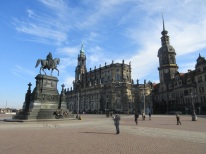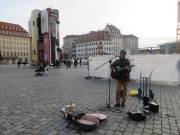


Deep in the heart of former East Germany, Dresden, the capital of the German state of Saxony, straddles the Elbe River near the border with the Czech Republic. This ancient city is known for its stunning collection of baroque buildings from the 18th century, including the Frauenkirche (originally built 1726, rebuilt 1993), and the Zwinger Palace (1719).
 The allied bombing of the Second World War in1945 left Dresden’s historic city center in ruins. Since then, much of it has been rebuilt and built up in an intriguing display of architectural styles. Wide pedestrian malls lined with Soviet-era apartment blocks reside among plazas flanked with 18th century buildings.
The allied bombing of the Second World War in1945 left Dresden’s historic city center in ruins. Since then, much of it has been rebuilt and built up in an intriguing display of architectural styles. Wide pedestrian malls lined with Soviet-era apartment blocks reside among plazas flanked with 18th century buildings.
 King August II (August the Strong), former King of Poland (1670-1733), was responsible for transforming Dresden into a magnificent baroque capital.
King August II (August the Strong), former King of Poland (1670-1733), was responsible for transforming Dresden into a magnificent baroque capital.  He established porcelain manufacturing in the nearby town of Meissen in 1710. For 150 years this factory produced the “White Gold” from the Meissen Albrechtsburg Castle, the oldest castle in Europe, which rises dramatically above the Elbe River valley.
He established porcelain manufacturing in the nearby town of Meissen in 1710. For 150 years this factory produced the “White Gold” from the Meissen Albrechtsburg Castle, the oldest castle in Europe, which rises dramatically above the Elbe River valley.
 One day I walked over the historic Augustus Bridge to explore Dresden’s Neustadt district. Here the gilded equestrian statue of August the Strong stands majestically at the head of a pedestrian mall, the center of which was filled with purple crocuses in full bloom.
One day I walked over the historic Augustus Bridge to explore Dresden’s Neustadt district. Here the gilded equestrian statue of August the Strong stands majestically at the head of a pedestrian mall, the center of which was filled with purple crocuses in full bloom.
At a doner kebab shop I met a friendly, local English-speaking lady named Silvia with her two year old daughter. Silvia spent 20 years of her life in Poland but  now lives in one of Dresden’s block apartment buildings in “group housing” with independent artists and writers and plans to live in Germany indefinitely. She only wears “free” clothes. When I asked if she was a citizen of Germany, she said she has no allegiance to any country. She said she speaks in English and Polish to her daughter, but not in German, confident that she will pick up German in school. Her friendliness and openness to me were heartwarming; her English was impeccable.
now lives in one of Dresden’s block apartment buildings in “group housing” with independent artists and writers and plans to live in Germany indefinitely. She only wears “free” clothes. When I asked if she was a citizen of Germany, she said she has no allegiance to any country. She said she speaks in English and Polish to her daughter, but not in German, confident that she will pick up German in school. Her friendliness and openness to me were heartwarming; her English was impeccable.

 At her encouragement, I later visited a unique DDR Museum (former Democratic Republic) which was located in a nearby modern two-story shopping mall. Labels were almost non-existant in this rather funky museum. Some of the most interesting artifacts there was a row of colorful Soviet-era cars and DDR military uniforms and memorabilia.
At her encouragement, I later visited a unique DDR Museum (former Democratic Republic) which was located in a nearby modern two-story shopping mall. Labels were almost non-existant in this rather funky museum. Some of the most interesting artifacts there was a row of colorful Soviet-era cars and DDR military uniforms and memorabilia. 
In my search for a historic public market, I found the multi-level, renovated Neustadter Markthalle (established 1899). It was usually humming with activity and became one of my favorite haunts for dining on a budget. Whenever I perched myself on a stool at one of the international food stalls, I usually became engaged in an interesting conversation, in English, with a local professional or *expat sitting next to me.
It was usually humming with activity and became one of my favorite haunts for dining on a budget. Whenever I perched myself on a stool at one of the international food stalls, I usually became engaged in an interesting conversation, in English, with a local professional or *expat sitting next to me.
 The popular weekly outdoor flea market along the Elbe River was another great place to interact with the locals. A couple of picture books of Dresden, which I browsed through, were especially interesting.
The popular weekly outdoor flea market along the Elbe River was another great place to interact with the locals. A couple of picture books of Dresden, which I browsed through, were especially interesting.  At first glance the photos of Dresden’s baroque center in these books appeared to be present-day photos. However, after careful inspection, I realized all the photos were taken before the Second World War.
At first glance the photos of Dresden’s baroque center in these books appeared to be present-day photos. However, after careful inspection, I realized all the photos were taken before the Second World War. 
The fact that I could barely tell the difference between the magnificent baroque buildings in the pre-war photos and the same structures viewed today, is testament to the remarkable reconstruction that has been done to Dresden’s old town since the devastating, controversial 1945 allied bombing which leveled most of it.









______________________________
*An expatriate (often shortened to “expat”) is a person temporarily or permanently residing in a country other than that of their citizenship.
Move your cursor over each photo for caption/description. iPad users – hold a finger on each photo for a few seconds for caption/description

What a fascinating city!
Dear Merrilee
Great to read your latest instalments and I will email this week. Your Dresden visit brought back memories from my 1995 visit. How quickly the years disappear – yet nothing much seems to change!
Take care xPauline
Hi Pauline,
Thank you for your comments. Glad you liked my postings of my adventures in Dresden.
Merrilee